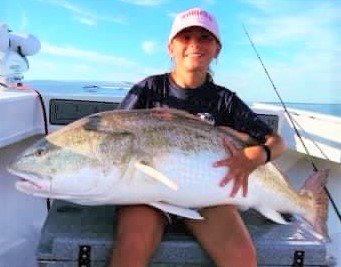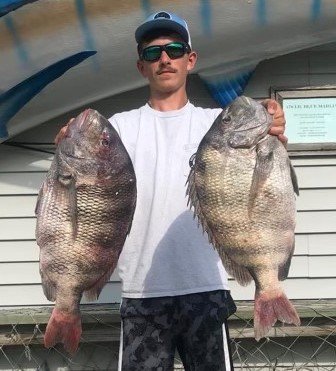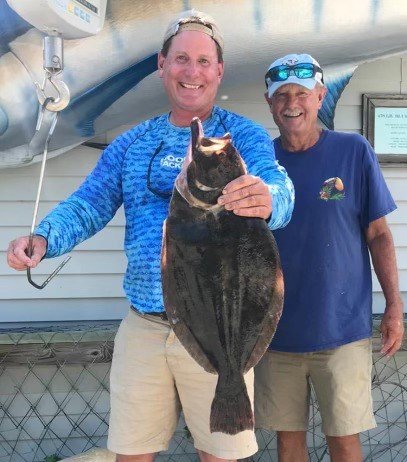
Not much has changed in fishing over the last week. Extra-warm water temperatures and excessive heat are forcing most anglers to fish early in the mornings and late in the afternoons. Coincidentally, this is when most of the highky productive action also occurs. Despite the heat, fishing is not too bad and you can’t catch anything unless you go. Just apply lots of sunscreen, stay hydrated, and keep an eye out for those sneaky afternoon thunderstorms that occasionally pop up out of nowhere.
Upper Shore/Chincoteague – Captain Matt Abell, of the Sea Hawk Sports Center, reports flounder, both inside the seaside inlets and on the inshore ocean wrecks, have been the most sought after target species by a majority of the shop’s customers. The cooler influx of ocean waters during the flood tide continues to be the most productive and most bearable period while fishing inside the inlets.
Silversides or live minnows combined with Berkley Gulps continue to be the preferred bait combinations inside, while jigs/gulps bounced off the wrecks are what has been working in the ocean waters. Triggerfish have been caught floating pieces of clam in a chum slick over the same wrecks, while a few cobia have hit jigs retrieved near the surface. Small croakers have been an unwelcome bycatch/bait stealers inside the inlet. Offshore, yellowfin tuna have been caught by chunking as well as on the troll. The Washington Canyon has also produced a few bigeye tuna and dolphin (mahi) catches. On the bayside, early morning fishing in the shallows has produced a few speckled trout and small rockfish.
Anglers trolling for Spanish mackerel should keep a spinning rod baited with a bucktail and curly-tailed jig ready in case the opportunity arises to cast at a surface cruising cobia. Bottom fishing has consisted mostly of kingfish (whiting), small croakers, and spot, with an occasional sheepshead or small black drum making a surprise appearance.
Wachapreague – Captain Lindsay Paul, just in from a charter trip, reported the flounder fishing out of Wachapreague was “still good” with finding clear water being the key to success. Paul said there were a number of pinhead croakers in the mix. The inshore ocean wrecks were still producing flounder and black sea bass. Paul added that a few billfish and tuna were being found in the offshore waters.
Amanda Manzella, at the Wachapreague Inn, said the flounder action is still producing “good” numbers of fish inside the inlet. A group of recent guests fished the inshore wrecks, limiting out on three consecutive days.
Lower Shore – Dez Louie, at Oceans East – Eastern Shore, described the current cobia action as “average,” explaining that a portion of the population are now post-spawn and have resumed feeding. Louie said the sight casters are having success finding cobia, as well as schools of red drum on the surface. Anglers bottom fishing for cobia are having to deal mostly with sharks and rays, while finding a few cobia for all of their effort. Anglers targeting spadefish with salted sea and chowder clams are finding lots of action, particularly around the third and fourth islands of the Chesapeake Bay Bridge-Tunnel.
Anglers fishing the bridge-tunnel pilings and the concrete ships with fiddler and cut blue crab baits have been battling large sheepshead. Anglers who prefer trolling have been catching Spanish mackerel and bluefish. Spanish mackerel have also been hitting Got-Cha plugs cast to breaking schools of surface-feeding fish. Keeper-sized flounder action has improved inside the Ditch and along the high rise. Catches off the Kiptopeke State Park Pier have included croakers, spot, gray trout, and ribbonfish.
Jeb Brady, at Bailey’s Bait & Tackle, told me the cobia fishing was “decent,” saying sight fishermen casting live eels were finding a decent amount of fish when the weather conditions were favorable. He added that bottom fishing for cobia remained slow, blaming spawning fish for the lack of bites. Brady said spadefishing with clam baits at the fourth island was very good, both in numbers and in the size of the fish. Brady added the cabbage patch to the list of recent productive sheepshead locations, in addition to the bridge-tunnel pilings. Anglers have been picking up Spanish mackerel by trolling spoons in the area between Cape Charles and Kiptopeke. Early season catches of puppy drum have been reported along the seaside marshes by anglers using popping corks and artificial baits. Catches of ribbonfish and small croakers have been made off the Cape Charles pier.
Bill Hall was the first Eastern Shore resident to achieve Virginia Salt Water Master Angler Status. He has been named Virginia Saltwater Angler of the Year and Virginia Saltwater Release Angler of the Year and is a Virginia Press Association award-winning sports columnist.





